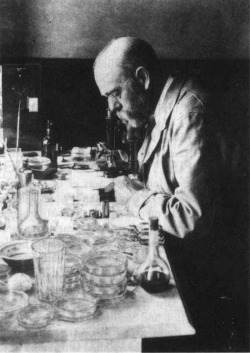All About Viruses and Bacteria
Koch's Postulate's

Robert Koch
Koch's postulates were designed by Robert Koch to isolate and see if a specific organism is causing a disease or sickness. Koch's postulate is a four step process that is used by scientist today. The first step is to isolate the virus for an infected person or animal. The sample of the bacteria must be pure. It can not be contaminated or this will affect the results. The second step is to smear the pure bacteria on a Petri dish and culture it. It will grow a pure colony of this bacterium. If the bacteria sample was not pure, the resulting culture of bacteria will also not be pure and contain other bacteria that may or may not be the cause of the illness. The third step is to take the newly grown bacteria and inject it into a healthy animal like a rat to see if it produces the same illness it did in the original case of the illness. If it does then you may have the right bacteria and you move onto step four, if it does not, you either have the wrong bacteria and you should still move onto step four, or you have an animal that is not affected by this illness. If it is not affected you need a different test subject for the pure culture of bacteria. Now in step four you re-isolate the bacteria you injected into the rat or other animal. This step is done to see if the bacteria you injected are still the same one that is causing the sickness. It could have change or it could be different bacteria the animal already had that caused the sickness. This process helps scientist find out what is making a group of animals or a group of people sick. If they find this information out they can find a cure. This process though is not helpful in finding a bacteria or pathogen that causes a chronic or minor illness. This process was designed to be used on acute diseases.
